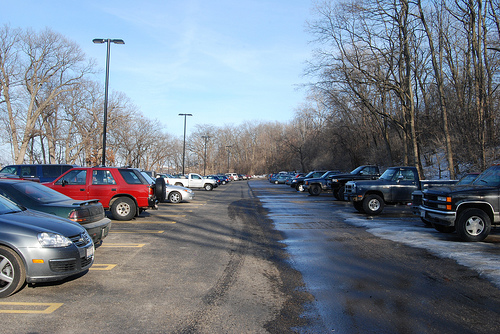4. Bioswales | 5. Permeable Pavement | 6. Cisterns
Permeable Pavement
 |
| Permeable vs. Traditional Pavement After Snowmelt |
What is Permeable Pavement
Permeable pavements are alternatives to traditional concrete and asphalt that allow the rain that falls on the surface of the material to pass through and infiltrate into the ground below.
Why use Permeable Pavements?
Traditional road, parking lot and walking path surfaces are made from concrete and asphalt, two materials that have been designed to have a very low porosity. These materials were originally used for paving because they resist the stress and strain caused by harsh weather and the weight of moving vehicles. However, the composition and structure of these materials also resist stormwater from permeating, turning the area they cover into an impervious surface. Permeable pavements are similar to the traditional paving materials because they resist the stress of vehicles, but are different because they allow water to pass through. The reason why permeable pavements are a favorable way of infiltrating stormwater is that instead of collecting, routing and transporting rain that lands on impervious surfaces, the impervious area is removed altogether and the water enters the ground where it lands.
How do they manage stormwater?
As mentioned, permeable pavements eliminate impervious areas in a watershed, without sacrificing road and parking space. The permeable pavement itself is only the top layer of a larger permeable pavement system. Water can pass through this first layer because it consists only of coarse particles, which are bound together. If fine particles are included in the mixture, they fill the space between larger particles, closing the gaps which water can pass through. Taking out these small particles means there are more pores that are filled with air or, after a rain event, water.
Beneath the top layer of porous pavement, there are bedding layers, which are also made of large particles with even more pore space. The bedding layers are not bound together, like the paving above it. The large gaps allow for large amounts of rain water to be stored in a sort of sub-surface reservoir.
While stormwater infiltrates through permeable pavement, it often removes pollutants from the water. Petroleum products often build up on surfaces that witness a lot of automobile traffic. These hydrocarbons can be harmful if they enter aquatic ecosystems with stormwater runoff. Fortunately, these hydrocarbons are trapped within the permeable pavement, and are prevented from either running off into streams or entering the ground water.
Are there any other benefits to having Permeable Pavement?
Sometimes, water can collect and pool on the top of surfaces paved with traditional materials. This standing water can reduce automobile traction, especially during the winter time when the water can freeze. Permeable pavements quickly absorb this water, reducing the chances of cars hydroplaning.
Are there any constraints / design considerations?
When designing a permeable paving there is one main tradeoff: between permeability and strength. The stronger the material, the fewer holes it can have; the more permeable, the weaker it is.
A big issue with permeable pavements is clogging. Although they originally have plenty of void space, fine particles flow onto the pavement from the surrounding area and fill the pores of the pavement as the water seeps downward. If this phenomenon is reoccurring, then the permeable pavement becomes permeable no longer. The only solution to this problem after it occurs is replacing the pavement.
Another consideration when designing a porous pavement system, is whether or not to include a geotextile fabric between two of the layers. The benefit that this fabric provides is a fine screen that collects sand particles and hydrocarbons, therefore improving the quality of water that enters the ground. However, the disadvantage is that the system is will likely clog faster. Geotextiles should only be used if it seems as though clogging will not be an issue.





